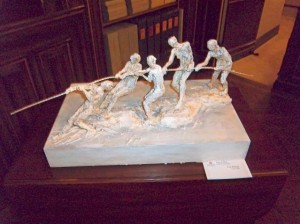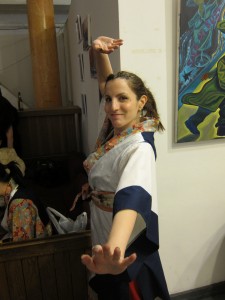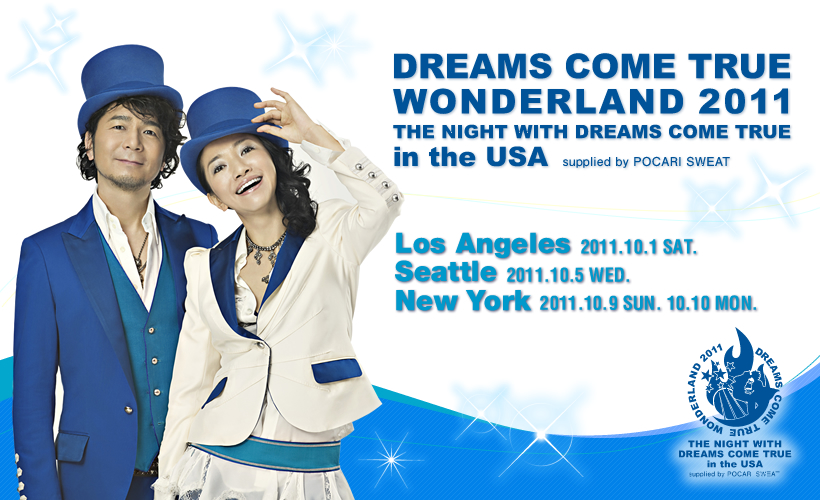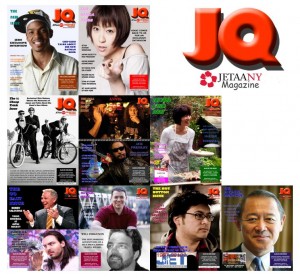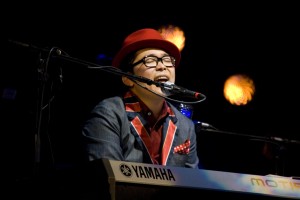JQ Magazine: JET Turned Laborer – Giving Back as a Volunteer in Post-Disaster Japan
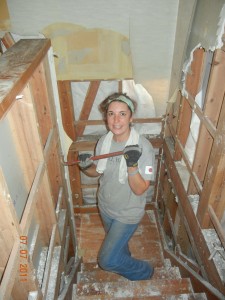
Rachel at work "gutting," or removing drywall panels and screws, in the stairwell of Wakadaisho, a sushi restaurant undergoing renovation in Ofunato, Iwate.
By Rachel Vigil-Garcia (Fukushima-ken, 2001-02) for JQ magazine. Rachel works at the American Center for Learning in Chula Vista, CA. Contact her at ray3vigil13 [at] yahoo [dot] com.
Eight months have passed since a huge earthquake and tsunami crippled Northeastern Japan with mind-numbing destruction. In March, news video beamed entire towns going under, with cars and homes lifted in the deluge. But today, why does it seem like so many have begun to forget about this disaster? I know the JET and JET alumni community are an exception to this. Still, I hope that by sharing my recent experience I can encourage sustained support to that wonderful island nation and its ever-gracious inhabitants. It’s much too early to be letting Japan’s victims and survivors, and the hard work ahead, fade into the background.
When news of the events of March 11 reached my living room in San Diego, it took hours for the magnitude and scope of the tragedy to sink in. I sat, scrolling through unbelievable Internet images with an eerie sense of irony as my mind brought me back 10 years. Suddenly, it wasn’t March 11, but September 11. I wasn’t in San Diego. I was on a tatami mat in my apartment in Koriyama, as a JET in Fukushima. The 9/11 terrorist attacks gripped the world in complete surprise. I was glued to NHK and local Fukushima TV, wondering how something so awful could be going on back home while I was thousands of miles away.
The realization of this strange twist of events compelled me to take action this summer. I was an ALT in Japan during the 9/11 terrorist attacks. Ten years later I felt the same helplessness and fright for Japan, a nation not mine by birthright, but one that had become a second home. With growing conviction and a sense of obligation, I vowed to find an organization accepting U.S. civilian volunteers. I was determined to help Japan recover and rebuild.
JQ Magazine: Book Review – ‘Life After the B.O.E. the Book’
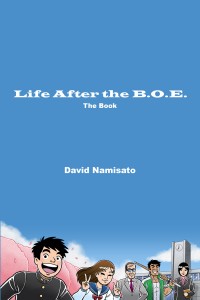
"This whimsical compilation of cartoons that appeared previously in JETAA publications worldwide is likely to hit the funny bone of both former and current program participants alike."
By Sharona Moskowitz (Fukuoka-ken, 2000-01) for JQ magazine. Sharona works at a literary agency in New York City. She is interested in fresh, new voices in fiction and creative nonfiction.
Flexibility and a sense of humor have long been predictors of a successful JET participant. And with good reason. After all, let’s face it: life in Japan for a gaijin can range from the frustrating to the absurd to the downright hilarious, often within the same day.
The malleable young JET is expected to smile and wear a variety of hats placed upon his or her head in the name of “international exchange.” For most JETs, it’s what happens in between the lines of the job description that makes the experience so meaningful.
Who better to capture the flexible thinking and sheer comedy of the JET experience than a former participant himself? JET alum and professional illustrator David Namisato (Aomori-ken CIR, 2002-04) showcases some of the more memorable aspects in his new book Life After the B.O.E. This whimsical compilation of cartoons that appeared previously in JETAA publications worldwide is likely to hit the funny bone of both former and current program participants alike.
Each cartoon presents a different familiar scenario. There is the moment of sudden awareness when it becomes all too clear to the ALT that he or she is more of an exotic show-and-tell object than a real teacher, a realization that can be disappointing, underwhelming, or just a huge relief, depending on who you ask. Read More
JQ Magazine: JETAANY Artist Showcase Unites Fukushima, New York
By Carolyn Brooks (Ishikawa-ken, 2006-11) for JQ magazine. Carolyn is co-author of the blog MadSilence–a cross-cultural blog written with her father–and a current culture/education related job-seeker in the New York area available for full-time or consulting work.
“At this festive season of the year, Mr. Scrooge,” said the gentleman, taking up a pen, “it is more than usually desirable that we should make some slight provision for [those in need], who suffer greatly at the present time….We choose this time, because it is a time, of all others, when Want is keenly felt, and Abundance rejoices.”
—Charles Dickens, A Christmas Carol, brackets by author.
It was in the generous spirit of the holiday season that over 150 guests, including former New York City mayor David Dinkins and a visiting delegation of dignitaries from Fukushima, joined together Dec. 1 for a reception and silent auction to show support for Tohoku as it continues to struggle after the Great Eastern Earthquake last March. The event, organized in partnership by the Consulate General of Japan in New York and the New York chapter of the JET Alumni Association (JETAANY), was held at Ambassador Shigeyuki Hiroki’s residence on the east side of Central Park.
JETAANY utilized its extensive network to get 14 artists involved, displaying and auctioning off more than 30 pieces of art including sculpture, prints, paintings and antique ceramics. The artists and donators really showed the scope of people who have connections with Japan, ranging from JET Program alumni and parents to Japanese expats and students. All in all, the auction raised $700, and with other donations received that night totaled more than $1300. Read More
JQ Magazine: Georgia JETs’ Ganbare Tohoku Shows Social Media Savvy
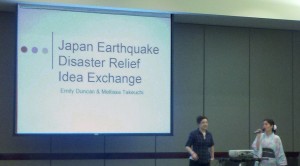
JET alumni Emily Duncan and Mellissa Takeuchi presenting at Georgia’s annual JapanFest, Sept. 17, 2011.
By Emily Duncan (Hyogo-ken, 2005-08) for JQ magazine. Emily is a graduate of the Lamar Dodd School of Art at the University of Georgia.
When I was a JET, I worked at Himeji Nishi Senior High School and enjoyed my time there immensely. I would love to return to Japan, if only for a visit.
Since a transcontinental, transpacific trip is a bit too much of a stretch for my wallet right now, I, like many of you, have an application essay ready for the day that JNTO begins their campaign for the 10,000 free flights to Japan (should the Diet rethink approving this plan for next spring, of course).
On March 11, 2011, I was asleep when the massive earthquake struck northeastern Japan (after all, it was about 1 a.m. in Atlanta). When I awoke, there was an e-mail news alert on my phone. I spent a chunk of time that morning trying to call friends in the Himeji area, but everyone was fine as they live about an hour west of Osaka. Plenty of room between them and disaster.
The rest of the day—the rest of the weekend, really—I spent occasionally checking in on the progression of events in Japan through news sources online. I reached out to the JETAASE and the Japan-America Society of Georgia with fundraising ideas. But neither group had decided upon a plan of action.
Impatient, I called my friend, Mellissa Takeuchi, fellow Hyogo-ken JET alum, to brainstorm. We thought of ideas for fundraising, but the one immediate and tangible takeaway from the conversation was that we should establish a Facebook page to catalogue the ongoing narrative of the Tohoku Earthquake, the tsunami disaster and the ensuing recovery effort.
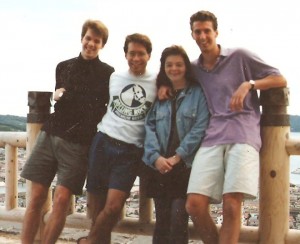
Alan (far right) with 1992-94 Kamaishi JETs (L to R: Kevin McCallum, Yves Lacasse, Kathryn Morris,) on top of Mt. Shiroyama, Ohtsuchi, 1992.
By Alan Mockridge (UK JET, Iwate-ken, 1992-94) for JQ magazine. Alan was one of 14 JET alums selected for the Tohoku Invitational Program sponsored by the Ministry of Foreign Affairs and the Japan Tourism Agency. He is a co-owner of Intralink, which provides business development services for U.S./European companies wishing to do business in/with Japan, China, Korea and Taiwan. Post-JET, he lived in Japan for 13 years before moving to Santa Clara, California in 2008. Intralink employs half a dozen fluent Japanese speaking JET alums in its Tokyo office.
Until a friend at university who I was studying German with suggested we apply for the JET Program as a year out after graduation, I could not even have located Japan on the map. On my application form I answered the question, “Do you have a placement request?” as “Somewhere rural.”
I got my wish. I was placed in Ohtsuchi, a fishing town of less than 15,000 people on Japan’s northeast Pacific coast, where I taught English as an assistant language teacher in three senior high schools: Ohtsuchi, Kamaishi Kita and Yamada. The experience changed my life but although I have remained intimately connected with Japan over the past 17 years, my direct links to these schools have naturally faded over time. That changed in the early hours of March 12, 2011 (PST).
When I saw the first earthquake and tsunami news reports coming out of Iwate my memories came racing back. I realized that I had lost contact with most of the teachers and townsfolk who had befriended me. There had been no e-mail or cell phones when I left in 1994, and gradually my New Year’s cards started to go undelivered from around 2008 as teachers were moved to different posts further and further from the coast. I decided I had to find them all again, just to tell them that I had not forgotten their kindness. Read More
JQ Magazine: JQ&A with Author/JET Alum David Namisato on ‘Life After the B.O.E. the Book’
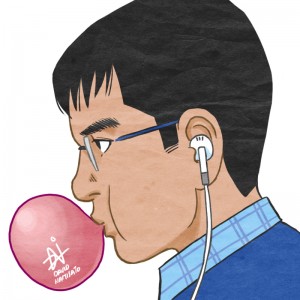
"The JET Programme mantra is “Every Situation is Different,” but so much of the frustrations and the joys that we encounter are very similar. I wanted a vehicle for us to laugh together." (Illustration courtesy of David Namisato)
By Rick Ambrosio (Ibaraki-ken, 2006-08) for JQ magazine. Rick manages the JET Alumni Association of New York (JETAANY)’s Twitter page and is the creator of the JETwit column Tadaima!
It’s probably happened to you over the last few years; you’re sitting at work, or maybe at home and an old buddy of yours from JET forwards you a link. You open it, and it’s a hilarious comic about life as a JET skillfully drawn with a mix of humor and nostalgia that pretty much makes your day. Life After the B.O.E. by David Namisato (Aomori-ken CIR, 2002-04) has given many a JET Alum a good laugh. If you’re anything like me, you’ve thought, “If this was a book, it would be a perfect Christmas present for those guys I still keep in contact with.” Well, David is happy to oblige.
David has now published a book of those comics, and we were lucky enough to catch up with him and pick his brain about it. With his comics popping up on other sites, it seems even a wider audience is getting into David’s work. In this exclusive interview, we ask him about his time on JET, his inspirations, and what he’s looking to do in the future.
What made you decide to publish this book?
I wasn’t planning to do a book initially, but a conversation with Lynn Miyauchi, JET Program Coordinator at the Consulate-General of Japan in Seattle, about the benefits of having a printed book (having something to read in your hands, something you can give as a gift) changed my mind.
So how did you get into art? Were you inspired at all by Japanese art/manga/etc.?
I drew a lot throughout childhood and dreamt of being a comic book artist. I grew up on a healthy diet of manga.
What brought you to Japan?
I was in the process of dropping out of animation school, and didn’t want to do anything art-related. I thought of some of the other skills I had, and I thought that the JET Programme would be an excellent way to transition myself in to a completely different career path.
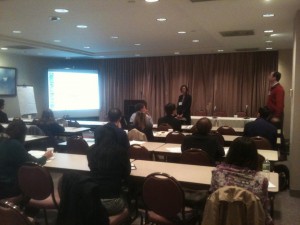
Amber Liang and Sean Harley explain the art of getting a job without ever asking (i.e., informational interviews). (Steven Horowitz)
By Carolyn Brooks (Ishikawa-ken, 2006-11) for JQ magazine. Carolyn is co-author of the blog MadSilence–a cross-cultural blog written with her father–and a current culture/education related job-seeker in the New York area available for full-time or consulting work.
JET alumni from all walks of life gathered this weekend at the Nippon Club in New York City to talk about something important to us all: jobs and how to get them. The Career Forum is a much-anticipated event, with JETAA New York providing a varied and well-planned series of presentations for recent returnees and new career searchers alike.
“We hold this event annually to help the recent returnees get settled back in New York, provide job hunting advice and techniques for highlighting the JET experience on their resume, and give them the opportunity to meet alumni and recruiters in their possible career fields,” said JETAANY president Monica Yuki (Saitama, 2002-04). The Career Forum achieved all those objectives with flying colors, as well as giving us recent returnees a taste of home, which for many of us suffering from reverse culture shock was as welcome as the career advice.
Evan Hyman (Osaka, 1995-96) started the presentations off with a bang, sharing the 10 most important lessons he’s learned in his 14 years since JET. Over the years he’s worked in marketing and planning with some of the world’s largest companies (including Pepperidge Farm and Johnson & Johnson), but that doesn’t mean he hasn’t encountered the same road bumps that new jobseekers do. Some of his advice included practical matters like “Network, network, network!”; “Utilize as many recruiters as you can”; and “Your job search will be determined by the economy”; but it was his more personal advice that really struck me.
Lesson #9 was “It can take a really long time to realize what you want to do.” Mr. Hyman’s had some jobs that, while lucrative and attractive, just weren’t for him. It was those jobs that helped him find his “sweet spot” and learn skills that got him the jobs he liked. No experience is ever wasted! Lesson #5, my personal favorite, was “Have a passion for what you do!” If you work at a job you’re not interested in, you’re not going to do your best work, so find your passion and see how you can use it in a career. Read More
By Sierra Soleil (Fukushima-ken, 2000-02) for JQ magazine. Sierra works at an ESL school in Manhattan. He enjoys teaching, writing, and riding his bike.
The first weekend of November marked the ninth annual Japan Arts Matsuri (JAM) in New York, this year at the Theater for the New City in the East Village. With about 30 volunteers and a handful of business sponsors, JAM put on an excellent show for roughly a thousand people over the three exciting days.
The entryway and lobby of the theater was crammed with tables selling everything from okashi and yakisoba to clothes and handicrafts, though most people in the know went directly for the Sendai miso cream puffs, and for good reason. There were even two carnival games: a simple one involving throwing a plastic katana at prizes, and an incomprehensible one where people poked little cookies with needles for some reason. Nearly every table was also raising money for earthquake/tsunami relief.
Every day of the three-day matsuri had music and dance performances, but Saturday was Talent Night, where performers could compete for a special invitation to perform at next year’s JAM. I wasn’t sure what to expect from Talent Night, which was good, because it was as wildly erratic as any cross-section of modern Japanese music and dance should be. The first act I caught was Robin’s Egg Blue, a cheerful acoustic pop group. They were followed by a band called Firesign, which was meant to be metal, though any spell they cast dissipated immediately when, as they left the stage, one of the emcees decided to reassure us that they were all very polite in person. After that there were modern and traditional dances, a gospel singer, a karaoke cover of Cee Lo Green’s smash hit (the “Forget You” version, of course), and a fascinating collaboration between a belly dancer and a beatboxer.
The show was billed as being like Amateur Night at the Apollo, and there was some resemblance. The acts were short, and before each intermission the audience chose their favorite via applause. Looking at the lineup, it occurred to me that JAM’s offering was a lot more diverse than anything I’ve seen at Amateur Night. One of the matsuri’s goals is to share Japanese culture with Americans, and the lesson to take from Talent Night is that culturally, the Japanese really are into everything. It also occurred to me that the power to vote by cheering for a performer we liked meant a lot less without the power to impeach them by booing.
I came to Talent Night specifically to meet with JET alumna Kirsten Phillips (Niigata-ken, 2005-08), a member of the Yosakoi Dance Project 10tecomai. The first impression she makes is everything a JET is supposed to be: energetic, cheerful, with a kind of wide-eyed enunciation that makes everything sound exciting. She went directly from teaching in Japan to teaching special education in New York, and it immediately seems like she would be good at it.
JQ Magazine: Film Review – Sion Sono’s ‘Cold Fish’ an Antisocially Acquired Taste

“In the end, Sono really does ask us about our humanity, and what life is about. Sure, he takes the bloody, abusive, rape-filled path, but he does touch on some solid stuff. It’s a lot of big questions wrapped in a gory, misogynistic, boob-exposing gift box.” (Courtesy Salient Media)
By Rick Ambrosio (Ibaraki-ken, 2006-08) for JQ magazine. Rick manages the JET Alumni Association of New York (JETAANY)’s Twitter page and is the creator of the JETwit column Tadaima!
I was hungry, real hungry after work and was about 20 minutes early to the New York Museum of Art and Design near Columbus Circle to see the movie Cold Fish 「冷たい熱帯魚」, so I walked a block to Good Burger and grabbed an overpriced hamburger. As I arrived back to the museum, I sat next to Shree (name changed to protect the innocent) who was midway through a burrito. With minutes left before the movie started, we headed into the museum and down some wooden steps to the theater. Walking in I was pretty surprised; we were only accompanied by seven or eight other patrons. Little did I know that it was a blessing in disguise…fewer people to feel awkward around after the movie.
Oh yes, the movie. How do I write about Cold Fish? It’s a little difficult. I suppose I can do it like this:
Cold Fish is a film directed by the controversial Sion Sono (whose month-long, eight-film retrospective wraps this week at MAD) and stars Denden and Mitsuru Fukikoshi. The film is based on real murders that took place in Fukushima. The story begins well enough: A timid man named Nobuyuki (Mitsuru Fukikoshi) with a rebellious daughter (Hiraki Kajiwara) and a hot trophy wife (gravure idol Megumi Kagurazaka) is feeling disconnected and regretful. They own a tropical fish shop. Through an awkward circumstance they meet Mr. Murata (Denden) and his attractive wife (Asuka Kurosawa), both of whom also own a tropical fish shop.
From there, shit just gets weird. That’s the only way I can explain it, folks. And it wasn’t just because the film cut out four times while we watched it. (Apparently, there were Blu-ray issues…through most of the movie. The museum might want to buy a new player before they hold another festival.) Anyway, Mr. Murata decides to bring Nobuyuki on as a partner, but not before hiring his daughter at his shop and sleeping with his wife (who apparently enjoys rough treatment, to put it mildly).
As Nobuyuki is introduced as the new partner, the old partner finds himself exiting the business via a poisonous death. This is where things kick into the next gear, and Murata forces Nobuyuki to assist with the disposal of the body. The whole body disposal process is presented with great detail. I’m serious about this part—after watching this movie, I am fairly confident that anyone could make a dead body disappear.
The plot then dives deeper and deeper into the dark comedy that is Murata’s utter disregard for human life and the director’s utter disregard for your stomach. By the way, did I mention that this film is very graphically violent? If you aren’t into that kind of thing, find another show; this movie revels in its ability to test what you can deal with gore-wise. If you enjoy severed heads and genitalia being tossed around a bathroom, you’ve found your dream movie.
JQ Magazine: Concert Review – DREAMS COME TRUE in New York City
By David A. in Virginia, special to JQ magazine.
Japanese mega-band DREAMS COME TRUE (ドリームズ・カム・トゥルー a.k.a. ドリカム) made a very rare U.S. appearance at the Highline Ballroom in New York City on October 9, the first of two shows that sold out within days of their announcement in July. Many thanks to fanpage DCT Joy for notifying its members of this wonderful event. For those of us not in New York, Los Angeles, or Seattle, we otherwise might not have known about it.
At dusk, around 6:30, the line already was down the block for admission to the inconspicuous Highline Ballroom in Chelsea. On this unseasonably warm October Sunday evening, the anticipation was palpable, the “DCT Joy” bringing alive the night. One walks upstairs to the ballroom, spare and easy to navigate. The management asks those seated on the floor of the “pit” to stand so that the crowd can fill the room.
First of all, a big shout-out to Justin Tedaldi (Kobe-Shi CIR, 2001-02) at JQ magazine. This reviewer cannot thank you enough. Also, thanks to Reiko from the DCT organization for her kind words.
Prior to the show, the house PA played a recording of some of DCT’s most well-known melodies, such as “Ano Natsu no Hanabi” and “Ureshii! Tanoshii! Daisuki!”, performed on soft bells.
Promptly at 8:00, introductions were made first by a woman in Japanese, to great enthusiasm from the audience; then a man said, “New York City! Are you ready for DREAMS COME TRUE?!” “A theme of the WONDERLAND” played as the fifteen-piece band-and-dance ensemble walked on stage, followed by Masato Nakamura (中村 正人). Although the Highline Ballroom has a standing capacity of 700, with a few dozen dinner tables on the balcony, the roar from the crowd was as if they were in an arena. With the theme concluded, Miwa Yoshida (吉田 美和) arrived, with her hair tied back and wearing a loose-fitting, light pink outfit; and, with her familiar exclamation “DREAMS COME TRUE in WONDERLAND….!!!”, the band launched into a heavy version of “Nando Demo,” as the crowd danced, waved, and cheered, encouraged by Miwa in all of her boundless energy.
JQ Magazine Is Looking for Writers for Fall 2011!
As the year winds down, JETAA New York’s JQ magazine continues to provide weekly content with an ever-expanding array of articles, interviews and features (for our recent stories, click here). Following our quarterly meeting in Manhattan this week, we’re now looking for new writers from all JETAA chapters worldwide to write and share more material that we can post online to the widest JET readership on the web through our hosts at the global JET alumni resource site JETwit.com.
Below are story ideas grouped by JET participants and alumni (JET World) and those more on Japanese culture (Japan World). If you’re a JET or JETWit contributor from anywhere in the world, we welcome your interest or extra story ideas! Contact JQ’s editor Justin Tedaldi (magazine [at] jetaany [dot] org) to sign up.
***JET WORLD***
JETAANY CAREER FORUM/WELCOME BACK RECEPTION (11/12)
We would like coverage of upcoming events in New York for any writers planning to attend.
JETs ‘RETURN TO TOHOKU’ SERIES
The Ministry of Foreign Affairs and the Japan Tourism Agency jointly organized an Invitation Program for JET Alums who worked as a JET in Iwate, Miyagi, Fukushima or Sendai-shi for 2 or more years to return to Japan as an ambassador. The goal of the program is to help promote the affected areas and do PR work on their behalf. From around the world, 14 JET alums were selected to return to Japan. Of those, eight were US JET alums. Visit the provided link to see their stories if you would be interested in doing a Q&A with one of them. Also, if you or other JETs are planning to return to help out in the wake of the devastation, we’d love to run an article so you can share your thoughts with other JETs around the world. www.jetaausa.com/tohoku-recovery/jet-alums-return-to-tohoku
‘ALONE IN THE KITCHEN WITH A RICE COOKER’ SERIES
We are running a new series on JETwit about solo cooking experiences while on JET (check out “Nattode,” the first piece in the series). Did you discover a new favorite comfort food in Japan, learn to cook a mouthwatering meal that you still serve today or accidentally buy something really weird only to discover (and reluctantly) eat it in your mansion? We want to hear about it!
HOLIDAYS IN JAPAN ANECDOTES WANTED!
This year, we’re bringing back seasonal holiday (from November through New Year’s) anecdotes from JET alumni around the world! If you have a strange, delightful (or both—we all do) short story to share about your holiday seasons past in Japan, we’d love to publish it.
JQ Magazine: Concert Review — Japan Society Hosts J-Pop Showcase with Yu Sakai and Cibo Matto
By Vlad Baranenko (Saitama-ken, 2000-02) for JQ magazine. Vlad is an avid photographer.
On Oct. 20, New York’s Japan Society held a sold out co-headlining performance by hometown heroes Cibo Matto and the Japanese singing sensation Yu Sakai in his international debut. Whether an aficionado of jazz, hip-hop, R&B or pop, the catchy synth beats of the girl duo and Yu Sakai’s melodic voice left an indelible impression on everyone in attendance.
Billed as J-Music Ride, the show opened with a set of fantastic vocal performances by Sakai. The breakout singer, whose professional music career kicked off in 2009 when his single titled “Story” became a radio hit, has quickly become one of Japan’s most admired artists, earning him the iTunes “J-Pop Best Album of 2010.” In June of this year, Sakai released his long-awaited album Yes!!, and those lucky enough to have attended the show (Yu Sakai’s only performance in the U.S.) were given an opportunity to sample many of the new tracks like “Train.”
Departing from the standard band format, the majority of instrumental sounds in Sakai’s pieces were recorded by the artist himself. At Japan Society, the artist would beatbox into the microphone to create a looping background rhythm, simulating a multi-layered chorus-like effect by sampling his own voice. He would then insert a fast paced piano tune, and the resulting melody astounded the audience, prompting whistles and applause during the song. To appease the American audience, Sakai-san surprised the concert attendees with his beautiful rendition of Michael Jackson’s “Rock with You.” In between pieces, Sakai would talk to the sold out crowd in a very nonchalant manner (he previously lived in Los Angeles), often making fun of himself and telling people to not be afraid to visit Japan. The obvious raw talent of Yu Sakai made this rare appearance a true gem, and the standing ovation from the audience at the end of his performance proved that this young artist can look forward to a bright future ahead.
JQ Magazine: JQ&A with Peelander-Yellow of Alien Punk Band Peelander-Z

Peelander-Yellow, center: "I don't care about Band!!!!! We never 'play' music!!!!! We just want to 'play' with youuuuuu!!!!! Come to see our show then check it yourself!!!!!!!!" (Whitney Lee)
By Justin Tedaldi (CIR Kobe-shi, 2001-02) and Vlad Baranenko (Saitama-ken, 2000-02) for JQ magazine.
Psychedelic, seizure inducing, and fantastically successful in their ability to cause absolute sensory overload during their intergalactic performances, Peelander-Z is back. The colorful Japanese punk group hailing from the Z area of Planet Peelander returns to New York City (where it formed in 1998) for their latest tour behind their new album Super DX Hitz.
Those yearning for their Peelander-Z fix will have the opportunity to experience all the colorful mayhem at the Bowery Poetry Club on Oct. 22. In this exclusive interview, we interrogate Peelander-Yellow to reveal the deepest secrets of their cosmic travel, their mastery of the chaos theory, and what the future holds for the ongoing kaiju saga.
Tell us about Peelander-Z’s Super DX Hitz album.
You can hear our all Hitz songs and understand Peelander-Z world!!!!!!!
28 happy songs and 5 Karaoke DVD!!!!
Get it for your Mom, because your Mom wants dance with youuuuuuuuuu and Peelander-Z!!!
How do you come up with the themes for your songs?
All ideas come from my sweet yellow brain when I eat medium rare S.T.E.A.K., Tacos, Ice Cream~~~~~!!!!!
What inspired you to form the band?
I don’t care about Band!!!!!
We never “play” music!!!!!
We just want to “play” with youuuuuu!!!!!
Come to see our show then check it yourself!!!!!!!!
Who is Peelander-Yellow and what’s his story?
I’m not Peelander-Red!
I’m not Peelander-Green!
I’m not Peelander-Pink!
I’m not Peelander-Black!
Yes, I’m Peelander-Yellow for youuuuuuuu!!!!!!
I was born from Banana on Planet Peelander!!!!!
That’s why I love it!!!!!
Please bring it for meeeeeee!!!!!
**************
The Rice Cooker Chronicles is a series of essays by JETs and JET alumni on the theme of cooking/eating and being alone in Japan. The brain-child of JETwit founder Steven Horowitz (Aichi-ken, Kariya-shi, 1992-94) (and inspired by the book Alone in the Kitchen with an Eggplant), this series is curated by L.M. Zoller (CIR Ishikawa-ken, Anamizu, 2009-11), the editor of The Ishikawa JET Kitchen: Cooking in Japan Without a Fight. A writer and translator for The Art of Japan: Kanazawa and Discover Kanazawa, ze also writes I’ll Make It Myself!, a blog about food culture in Japan.
New submissions always welcome. E-mail us at jetwit [at] jetwit.com.
**********
“Nattode”
By JQ magazine editor Justin Tedaldi (CIR Kobe-shi, 2001-02). Visit his Examiner.com page for related Japanese culture stories.
I’m at a restaurant that bleeds sophistication. Seated across from me is a stunning member of the opposite sex, joining me for the sole purpose of sampling the house’s signature dish, a personal favorite of mine.
Tender music swells in the background. The lighting is perfect, with the glow of candlelight on the table framing my partner’s irresistible charms as a celebrated bon vivant holds court four tables over. Spirits are high, and we’re high on spirits. The mood is ripe.
I snap my fingers to cue the waiter, who gracefully sets two silver trays before us. “Enjoy,” he says dryly. I look him straight in the eye and grin, signaling as I have many times before that I fully intend to.
It’s time. Gloved hands raise the lids, revealing…a small pair of Styrofoam trays with thin sheets of plastic on top. My date is puzzled.
JQ Magazine: Book Review – ‘Aftershock: Artists Respond to Disaster in Japan’

“I assumed a response to the earthquake would be grim. I was, however, relieved to see that there is a nice dose of playfulness alongside the serious, an homage to resilience and the inimitable Japanese sense of humor.” (Big Ugly Robot Press)
By Sharona Moskowitz (Fukuoka-ken, 2000-01) for JQ magazine. Sharona works at a literary agency in New York City. She is interested in fresh, new voices in fiction and creative nonfiction.
Composed in the wake of the catastrophic events of 3/11, Aftershock is something of a series of love letters to Japan written in the object of affection’s own familiar dialect: manga. Edited and compiled by American-born and Nagoya-based cartoonist Adam Pasion (Sundogs), the range of over 35 artists/admirers runs the gamut from the seasoned foreign resident to the casual Japanophile, each with an individual style and tone. The pieces are as eclectic as the artists’ experiences and personal ties to Japan, and all proceeds from Aftershock will be donated to relief efforts in northeast Japan.
When I first approached the anthology I wasn’t sure what to expect though I braced myself for gravity. Even in the form of manga, I assumed a response to the earthquake would be grim. I was, however, relieved to see that there is a nice dose of playfulness alongside the serious, an homage to resilience and the inimitable Japanese sense of humor.
For example, “I Was a Teenage Otaku” by JET alum and Tohonharu cartoonist Lars Martinson (Fukuoka-ken, 2003-06) traces the trajectory of the author’s interest in manga and anime, a hobby which “provided the spark that made [him] want to get out there and really explore” and eventually led to his move to Japan as an exchange student. Though his passion for the art form eventually waned, it gave way to a much broader appreciation of the Japanese arts in general.

